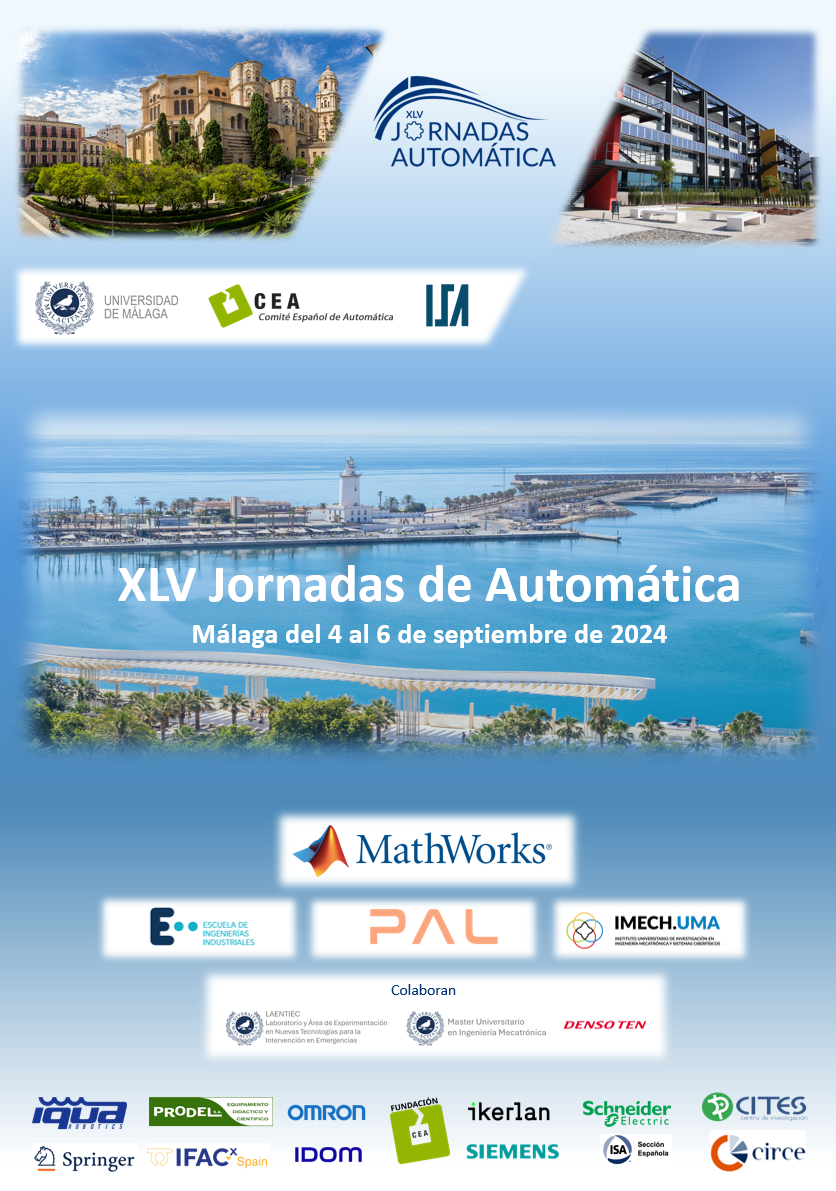Detección de actividades mediante modelos ocultos de Markov jerárquicos
DOI:
https://doi.org/10.17979/ja-cea.2024.45.10778Palabras clave:
Métodos bayesianos, Modelos de series temporales, Control basado en eventos, Control basado en el conocimiento, Informática basada en el ser humanoResumen
En los últimos años, el interés en el desarrollo de tecnologías avanzadas para detectar y analizar las actividades y los patrones de comportamiento de las personas mayores en sus hogares ha crecido, con el objetivo de mejorar su salud y bienestar. Este artículo explora el uso de Modelos Ocultos de Markov Jerárquicos (HHMM) para abordar estos desafíos. Los HHMM permiten la representación y análisis de secuencias temporales de actividades, capturando tanto variaciones a corto plazo como estructuras jerárquicas complejas en los comportamientos humanos. Se presenta una arquitectura que incluye sensores no intrusivos y un robot social para la monitorización y atención de personas mayores en sus viviendas. Se han expuesto los principios matemáticos del modelo HHMM y la ejecución de sus algoritmos de predicción. El sistema ha sido validado en cinco viviendas reales durante dos meses, proporcionando como resultado los patrones de comportamiento de los usuarios con el fin de detectar las posibles anomalías que pueden ocurrir.
Referencias
Bhola, G., Vishwakarma, D. K., 2024. A review of vision-based indoor har: state-of-the-art, challenges, and future prospects. Multimedia Tools and Applications 83 (1), 1965–2005.
Gaikwad, S., Bhatlawande, S., Shilaskar, S., Solanke, A., 2023. A computer vision-approach for activity recognition and residential monitoring of elderly people. Medicine in Novel Technology and Devices 20, 100272.
Glennie, R., Adam, T., Leos-Barajas, V., Michelot, T., Photopoulou, T., McClintock, B. T., 2023. Hidden markov models: Pitfalls and opportunities in ecology. Methods in Ecology and Evolution 14 (1), 43–56.
Golestani, N., Moghaddam, M., 2020. Human activity recognition using magnetic induction-based motion signals and deep recurrent neural networks. Nature communications 11 (1), 1551.
Gómez-Ramos, R., Duque-Domingo, J., Zalama, E., Gómez-García-Bermejo,J., 2023. An unsupervised method to recognise human activity at homeusing non-intrusive sensors. Electronics 12 (23), 4772
Howedi, A., Lotfi, A., Pourabdollah, A., 2020. An entropy-based approach for anomaly detection in activities of daily living in the presence of a visitor. Entropy 22 (8), 845.
Jethanandani, M., Sharma, A., Perumal, T., Chang, J.-R., 2020. Multi-label classification based ensemble learning for human activity recognition in smart home. Internet of Things 12, 100324.
Jouini, R., Houaidia, C., Saidane, L. A., 2023. Hidden markov model for early prediction of the elderly’s dependency evolution in ambient assisted living. Annals of Telecommunications 78 (9), 599–615.
Jung, M., Chi, S., 2020. Human activity classification based on sound recognition and residual convolutional neural network. Automation in Construction 114, 103177.
Konios, A., Garcia-Constantino, M., Christopoulos, S.-R., Mustafa, M. A., Ekerete, I., Shewell, C., Nugent, C., Morrison, G., 2019. Probabilistic analysis of temporal and sequential aspects of activities of daily living for
abnormal behaviour detection. In: 2019 IEEE SmartWorld, Ubiquitous Intelligence & Computing, Advanced & Trusted Computing, Scalable Computing & Communications, Cloud & Big Data Computing, Internet of People and Smart City Innovation (SmartWorld/SCALCOM/UIC/ATC/CBDCom/IOP/SCI). IEEE, pp. 723–730.
Li, Y., Yang, G., Su, Z., Li, S., Wang, Y., 2023. Human activity recognition based on multienvironment sensor data. Information Fusion 91, 47–63.
Nagpal, D., Gupta, S., Kumar, D., Illes, Z., Verma, C., 2023. goldenager: A personalized feature fusion activity recognition model for elderly. IEEE Access.
Nawal, Y., Oussalah, M., Fergani, B., Fleury, A., 2023. New incremental svm algorithms for human activity recognition in smart homes. Journal of Ambient Intelligence and Humanized Computing 14 (10), 13433–13450.
Novak, M., Jakab, F., Lain, L., 2013. Anomaly detection in user daily patterns in smart-home environment. J. Sel. Areas Health Inform 3 (6), 1–11.
Ordóñez, F. J., de Toledo, P., Sanchis, A., 2015. Sensor-based bayesian detection of anomalous living patterns in a home setting. Personal and Ubiquitous Computing 19, 259–270.
Paudel, R., Eberle, W., Holder, L. B., 2018. Anomaly detection of elderly patient activities in smart homes using a graph-based approach. In: Proceedings of the 2018 International Conference on Data Science. pp. 163–169.
Ramos, R. G., Domingo, J. D., Zalama, E., Gomez-Garc ´ ´ıa-Bermejo, J.,Lopez, J., 2022. Sdhar-home: A sensor dataset for human activity recognition at home. Sensors 22 (21), 8109.
Saives, J., Pianon, C., Faraut, G., 2015. Activity discovery and detection of behavioral deviations of an inhabitant from binary sensors. IEEE Transactions on Automation Science and Engineering 12 (4), 1211–1224.
Schrader, L., Vargas Toro, A., Konietzny, S., Ruping, S., Sch ¨ apers, B., Steinbock, M., Krewer, C., Müller, F., Güttler, J., Bock, T., 2020. Advanced sensing and human activity recognition in early intervention and rehabilitation of elderly people. Journal of Population Ageing 13, 139–165.
Sousa Lima, W., Souto, E., El-Khatib, K., Jalali, R., Gama, J., 2019. Human activity recognition using inertial sensors in a smartphone: An overview. Sensors 19 (14), 3213.
Wang, X., Liu, J., Moore, S. J., Nugent, C. D., Xu, Y., 2023a. A behavioural hierarchical analysis framework in a smart home: Integrating hmm and probabilistic model checking. Information Fusion 95, 275–292.
Wang, Y., Wang, X., Arifoglu, D., Lu, C., Bouchachia, A., Geng, Y., Zheng, G., 2023b. A survey on ambient sensor-based abnormal behaviour detection for elderly people in healthcare. Electronics 12 (7), 1539.
Wilson, D. H., Atkeson, C., 2005. Simultaneous tracking and activity recognition (star) using many anonymous, binary sensors. In: International Conference on Pervasive Computing. Springer, pp. 62–79.
Descargas
Publicado
Número
Sección
Licencia
Derechos de autor 2024 Raúl Gomez Ramos, Jaime Duque-Domingo, Eduardo Zalama, Jaime Gómez-García-Bermejo

Esta obra está bajo una licencia internacional Creative Commons Atribución-NoComercial-CompartirIgual 4.0.





